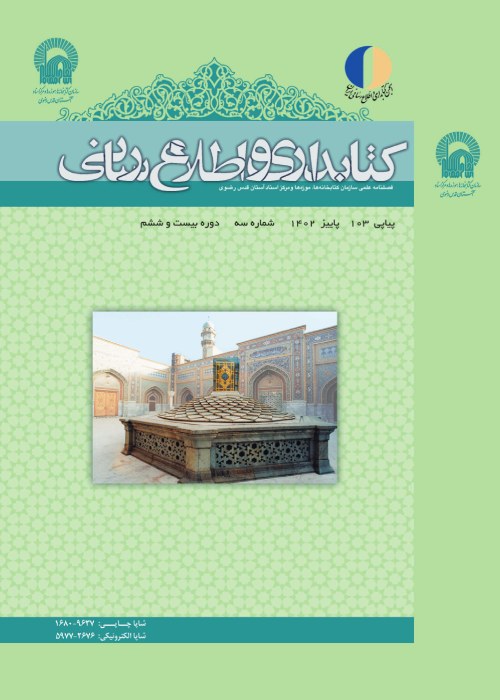An Investigation into the Needs and Information Resources of Cancer Patients in the Components of Information Literacy Treatment
Author(s):
Article Type:
Research/Original Article (دارای رتبه معتبر)
Abstract:
Objective
Information literacy treatment is a new concept that is an important part of the disease process and patients should have good information in this area. Therefore, the main purpose of the present study is a study of the needs and information resources for cancer patients in the components of information literacy treatment.
Methodology
The research is an applied type that was conducted by survey method. The statistical population of the study consisted of 570 cancer patients who completed their treatment stages at Omid Hospital in Mashhad. They were referred to this center at the time of conducting the research. 230 patients were selected by stratified random sampling as sample size. Data were collected through a researcher-made questionnaire that includes 37 items for 6 components of information treatment literacy (medications, treatment, nutrition, tests, treatment costs and sport) as well as 19 items on various sources of information literacy treatment. The method of scoring the questionnaire was based on a Likert scale (from 1 to 5). The validity of the questionnaire has confirmed by specialists and stability of the questionnaire also approved considering to Cornbrash's coefficient alpha. To calculate the Cronbach's alpha coefficient, 30 questionnaires were distributed among the sample, the results showed that in all dimensions of the questionnaire, the coefficient was more than 9/0.
Findings
The findings showed that among 6 components of information literacy treatment, 5 components such as medication, treatment, nutrition, testing and treatment costs are the most information needs of the patient and their least information needed was allocated with an average of 2.72 in the sport component. In relation to the information resources, the lowest mean refers to educational classes and the hospital librarian and only in 5 sources, the average was higher than the average level (3), these sources of information were in the order of average: "therapist", "other non-specialists in the disease", "hospital nurse", "nurse in the department of chemotherapy", and "other patients with the same illness".
Conclusion
Patients' resources and how to understand the use of information resources should be given special attention because patients are exposed to a wide range of information sources. The role of hospital librarians in this regard can be very high, as they can provide information to the medical staff and also patients because they have enough cognitive information resources and they have the ability to identify quality and reliability of information.Keywords:
Language:
Persian
Published:
Library and Information Science, Volume:22 Issue: 1, 2019
Pages:
54 to 71
magiran.com/p2013683
دانلود و مطالعه متن این مقاله با یکی از روشهای زیر امکان پذیر است:
اشتراک شخصی
با عضویت و پرداخت آنلاین حق اشتراک یکساله به مبلغ 1,390,000ريال میتوانید 70 عنوان مطلب دانلود کنید!
اشتراک سازمانی
به کتابخانه دانشگاه یا محل کار خود پیشنهاد کنید تا اشتراک سازمانی این پایگاه را برای دسترسی نامحدود همه کاربران به متن مطالب تهیه نمایند!
توجه!
- حق عضویت دریافتی صرف حمایت از نشریات عضو و نگهداری، تکمیل و توسعه مگیران میشود.
- پرداخت حق اشتراک و دانلود مقالات اجازه بازنشر آن در سایر رسانههای چاپی و دیجیتال را به کاربر نمیدهد.
دسترسی سراسری کاربران دانشگاه پیام نور!
اعضای هیئت علمی و دانشجویان دانشگاه پیام نور در سراسر کشور، در صورت ثبت نام با ایمیل دانشگاهی، تا پایان فروردین ماه 1403 به مقالات سایت دسترسی خواهند داشت!
In order to view content subscription is required
Personal subscription
Subscribe magiran.com for 70 € euros via PayPal and download 70 articles during a year.
Organization subscription
Please contact us to subscribe your university or library for unlimited access!



